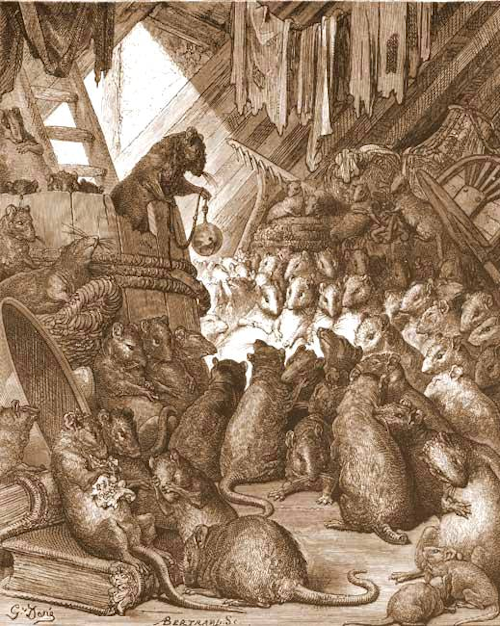Belling The Cat
Illustrates Courage, Accountability, Gap Between Ideas and Action
When Agile teams talk about transformation, improvement, or risk-taking, it's easy to generate clever plans and passionate intentions. But when the moment of action arrives, courage often disappears. Belling the Cat, an old Aesop fable1, offers a sharp lens on the difference between wishful thinking and meaningful action.
This tale is especially relevant for Scrum Masters, Agile Coaches, and change agents who find themselves in organizations full of bold conversations but slow follow-through.

Once upon a time, the mice held a meeting. They lived in constant fear of the house cat. Every day, someone narrowly escaped, and every night, the cat prowled the kitchen while the mice hid in silence.
One clever mouse stood up and declared, “I have a plan! We shall hang a bell around the cat's neck. That way, we'll always hear it coming.”
The room exploded in applause. “Brilliant!” “At last, safety!” “Why didn't we think of this sooner?”
But then an elder mouse raised a quiet question: “Who will bell the cat?”
Silence fell. The plan, once praised, now hung in the air like smoke. Every mouse looked away, avoided eye contact, and muttered excuses. In the end, the cat remained unbothered, and the mice stayed hidden.
Lessons Learned
Good Ideas Are Not Enough
The mice had a clear strategy. The problem was not the plan, but the execution. Agile teams often fall into the same trap: impressive presentations, sticky-note workshops, and Retrospectives filled with bold ideas that never become action. Without follow-through, even the best strategy changes nothing.
Risk Always Has a Price
Everyone wanted the bell around the cat's neck. No one wanted to be the one to place it there. In Agile environments, transformation often demands risk: challenging norms, surfacing dysfunction, or confronting uncomfortable truths. Progress requires someone willing to step forward, even when it's uncomfortable.
Safety Shapes Behavior
The elder mouse wasn't being cynical, just realistic. Without psychological safety, teams will hesitate to act. When people fear blame, ridicule, or failure, action stalls. Creating a culture where people feel safe to raise hard topics and try brave things is foundational to agility.
Consensus Can Be a Mirage
The room celebrated the idea. But agreement without accountability is hollow. Agile ceremonies like Planning and Retrospectives often produce group consensus, but who actually owns the change? The fable warns us not to confuse vocal support with real commitment.
Real Change Requires Real Commitment
The mice wanted someone else to act. Until someone says, “I'll do it,” nothing changes. In Agile teams, improvement often relies on individual courage. We move from intention to transformation when someone claims ownership and follows through.
Coaching Tips
- Use This Story to Challenge the Status Quo: If your team has great ideas that never get implemented, read this fable aloud and ask, “Where are we avoiding action?”
- Spot the Unnamed Cat: Many teams have an invisible “cat” - a person, process, or fear that stifles growth. Invite teams to name what they're tiptoeing around.
- Foster Psychological Safety: Help teams explore what would make it safe enough to “bell the cat.” This opens the door to healthy conflict, experimentation, and courage.
- Use This Story for Release Planning: Many teams plan like the hare, all-in and full throttle. Use the parable to frame smaller, spaced delivery goals that build confidence over time.
- Make Action Explicit: During Retros or planning, ask not just what will change, but who will lead the charge. Clarity of ownership turns ideas into movement.
Belling the Cat reminds us that big change does not happen through brilliant plans. It happens when someone steps forward. As Agile coaches and Scrum Masters, our job is not just to host the meeting. It is to help someone find the courage to tie the bell.
Without action, nothing changes.
With courage, everything might.


